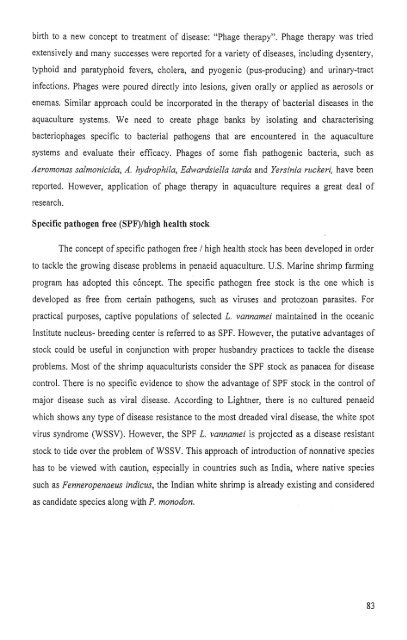, Diagnosis an-&& of Shrimp Diseases - Central Institute of ...
, Diagnosis an-&& of Shrimp Diseases - Central Institute of ...
, Diagnosis an-&& of Shrimp Diseases - Central Institute of ...
- No tags were found...
Create successful ePaper yourself
Turn your PDF publications into a flip-book with our unique Google optimized e-Paper software.
irth to a new concept to treatment <strong>of</strong> disease: "Phage therapy". Phage therapy was triedextensively <strong>an</strong>d m<strong>an</strong>y successes were reported for a variety <strong>of</strong> diseases, including dysentery,typhoid <strong>an</strong>d paratyphoid fevers, cholera, <strong>an</strong>d pyogenic (pus-producing) <strong>an</strong>d urinary-tractinfections. Phages were poured directly into lesions, given orally or applied as aerosols orenemas. Similar approach could be incorporated in the therapy <strong>of</strong> bacterial diseases in theaquaculture systems. We need to create phage b<strong>an</strong>ks by isolating <strong>an</strong>d characterisingbacteriophages specific to bacterial pathogens that are encountered in the aquaculti~resystems <strong>an</strong>d evaluate their efficacy. Phages <strong>of</strong> some fish pathogenic bacteria, such asAeronzonas salmonicida, A. hydrophila, Edwardsiella tarda <strong>an</strong>d Yersinia ruckeri, have beenreported. However, application <strong>of</strong> phage therapy in aquaculture requires a great deal <strong>of</strong>research.Specific pathogen free (SPQIhigh health stockThe concept <strong>of</strong> specific pathogen free / high health stock has been developed in orderto tackle the growing disease problenls in penaeid aquaculture. U.S. Marine shrimp farmingprogram has adopted this cincept. The specific pathogen free stock is the one which isdeveloped as free from certain pathogens, such as viruses <strong>an</strong>d protozo<strong>an</strong> parasites. Forpractical purposes, captive populatioiis <strong>of</strong> selected L. v<strong>an</strong>namei maintained in the oce<strong>an</strong>ic<strong>Institute</strong> nucleus- breeding center is referred to as SPF. However, the putative adv<strong>an</strong>tages <strong>of</strong>stock could be useful in conjunction with proper husb<strong>an</strong>dry practices to tackle the diseaseproblems. Most <strong>of</strong> the shrimp aquaculturists consider the SPF stock as p<strong>an</strong>acea for diseasecontrol. There is no specific evidence to show the adv<strong>an</strong>tage <strong>of</strong> SPF stock in the control <strong>of</strong>major disease such as viral disease. According to Lightner, there is no criltured penaeidwhich shows <strong>an</strong>y type <strong>of</strong> disease resist<strong>an</strong>ce to the most dreaded viral disease, the white spotvirus syndrome (WSSV). However, the SPF L. v<strong>an</strong>namei is projected as a disease resist<strong>an</strong>tstock to tide over the problem <strong>of</strong> WSSV. This approach <strong>of</strong> introduction <strong>of</strong> nonnative specieshas to be viewed with caution, especially in countries such as India, where native speciessuch as Fenneropenaeus indicz~s, the Indi<strong>an</strong> white shrimp is already existing <strong>an</strong>d consideredas c<strong>an</strong>didate species along with P. monodon.
















